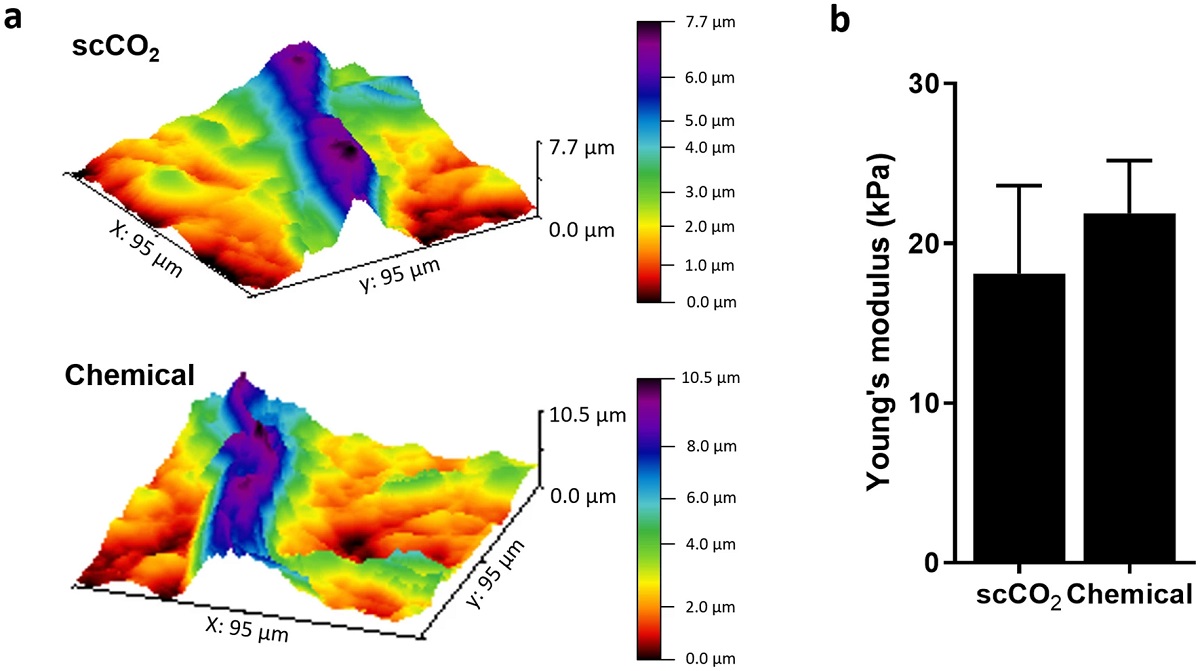Biocompatible scaffolds that can be repopulated with human cells have many uses such serving as replacement organs and tissues. Therefore there is an increasing interest in plant-based biomaterials for tissue engineering.*
As the above mentioned scaffolds should mimic the in vivo tissue environment closely they need to provide a fitting structural and biomechanical support to the cells while at the same time promoting cell behaviour and tissue development. *
Currently the standard method to prepare plant tissue to serve as a biocompatible scaffold is to decellularize it with serial chemical treatment.*
In their article “Supercritical carbon dioxide decellularization of plant material to generate 3D biocompatible scaffolds” Ashlee F. Harris, Jerome Lacombe, Sumedha Liyanage, Margaret Y. Han, Emily Wallace, Sophia Karsunky, Noureddine Abidi and Frederic Zenhausern explore another method to produce biocompatible scaffolds.*
They use supercritical carbon dioxide (scCO2) together with 2% peracetic acid to decellularize plant material.*
Their subsequent investigations show that the process of decellularization, scaffold structure preservation and recellularization with human cells is less time consuming than with the standard chemical method.
In a further step the authors of the article describe how they use various scientific methods to evaluate the scaffolds they decellularized by the described scCO2 method.*
Ashlee F. Harris et al. use Atomic Force Microscopy (AFM) in order to find out if the scCO2 treatment had an impact on the mechanical properties of the scaffolds produced with this method.*
With AFM topography measurements they are able to establish that structures such as plant vasculature were preserved.*
The following determination of the Young’s Modulus calculated from multiple force curves of a homogeneous surface section of the produced scaffold shows it to be slightly lower than the one from a chemically decellularized scaffold.*
NANOSENSORS™ uniqprobe qp-BioAC AFM probes ( CB3 nominal values: 80 μm length, 30 μm mean width, 400 nm thickness, force constant 0.06 N/m, resonance frequency 30 kHz) were used for the scaffold measurements with Atomic Force Microscopy.

While the scCo2 method promises to be a faster way to decellularize plant material and produce sterile and biocompatible scaffolds further research will be necessary to determine whether the differences the authors detected between the scaffolds produced with the scCO2 approach and the scaffolds produced with the chemical approach have a major influence on how repopulated cells behave in the achieved scaffolds.*
*Ashlee F. Harris, Jerome Lacombe, Sumedha Liyanage, Margaret Y. Han, Emily Wallace, Sophia Karsunky, Noureddine Abidi and Frederic Zenhausern
Supercritical carbon dioxide decellularization of plant material to generate 3D biocompatible scaffolds
Nature Scientific Reports 11, 3643 (2021)
DOI: https://doi.org/10.1038/s41598-021-83250-9
Please follow this external link to read the full article: https://rdcu.be/cAqW3
Open Access The article “Supercritical carbon dioxide decellularization of plant material to generate 3D biocompatible scaffolds” by Ashlee F. Harris, Jerome Lacombe, Sumedha Liyanage, Margaret Y. Han, Emily Wallace, Sophia Karsunky, Noureddine Abidi and Frederic Zenhausern is licensed under a Creative Commons Attribution 4.0 International License, which permits use, sharing, adaptation, distribution and reproduction in any medium or format, as long as you give appropriate credit to the original author(s) and the source, provide a link to the Creative Commons license, and indicate if changes were made. The images or other third party material in this article are included in the article’s Creative Commons licence, unless indicated otherwise in a credit line to the material. If material is not included in the article’s Creative Commons licence and your intended use is not permitted by statutory regulation or exceeds the permitted use, you will need to obtain permission directly from the copyright holder. To view a copy of this licence, visit http://creativecommons.org/licenses/by/4.0/.